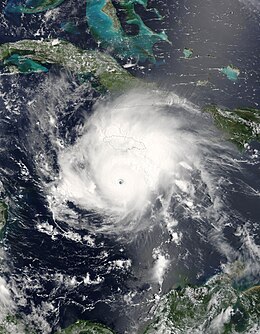Hurricane Emily (2005)
| Category 5 major hurricane (SSHWS/NWS) | |

Hurricane Emily near peak intensity south of Jamaica on July 16
|
|
| Formed | July 11, 2005 |
|---|---|
| Dissipated | July 21, 2005 |
| Highest winds |
1-minute sustained: 160 mph (260 km/h) |
| Lowest pressure | 929 mbar (hPa); 27.43 inHg |
| Fatalities | 17 total |
| Damage | $1 billion (2005 USD) |
| Areas affected | Guyana, Windward Islands, Leeward Antilles, Venezuela, Puerto Rico, Hispaniola, Colombia, Jamaica, Cuba, Cayman Islands, Honduras, Belize, Mexico, Texas |
| Part of the 2005 Atlantic hurricane season | |
Hurricane Emily was a powerful, early season tropical cyclone that caused significant damage across the Caribbean Sea to Mexico. A Cape Verde-type hurricane, the storm formed on July 10, 2005, in the central Atlantic Ocean before passing through the Windward Islands on July 14. Tracking generally towards the west-northwest, the storm gradually intensified as it traversed the Caribbean, peaking as a Category 5 hurricane on July 16, marking the earliest date for a storm to do so during the course of a given year. The system subsequently made landfall in the Yucatán Peninsula as a Category 4. Quickly crossing the peninsula, Emily emerged into the Gulf of Mexico and reorganized. On July 20, the storm struck Tamaulipas as a major hurricane and rapidly dissipated within 24 hours.
When its central pressure fell to 929 mbar and its sustained winds reached 160 mph (260 km/h) on July 16, Emily became the strongest hurricane ever to form before August, breaking a record set by Hurricane Dennis just six days before. It was also the earliest Category 5 hurricane ever recorded in the Atlantic basin (beating Hurricane Allen's old record by nearly three weeks) and the only Category 5 hurricane ever recorded before August.
Tropical Depression Five formed in the central tropical Atlantic the evening of July 10. Late on July 11, it strengthened and was named Tropical Storm Emily. Initially forecast to strengthen rapidly and move west-northwest through the Greater Antilles, Emily instead moved almost due west toward the Windward Islands, remaining a moderate tropical storm. The storm languished while moving quickly west, and struggled with maintaining its form. Contrary to the normal occurrence that hurricanes leave a cold wake behind, Hurricane Dennis had made portions of the Caribbean Sea warmer, and therefore more favorable for tropical cyclone development. Late on July 13, Emily strengthened rapidly and reached hurricane strength while passing Tobago and entering the eastern Caribbean. On July 14, Emily made landfall in northern Grenada with 90 mph (145 km/h) winds.
...
Wikipedia
